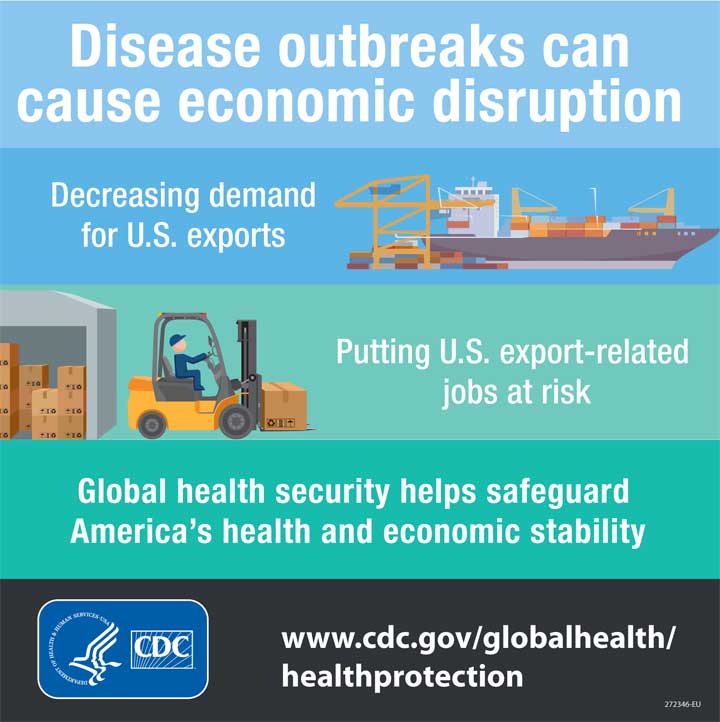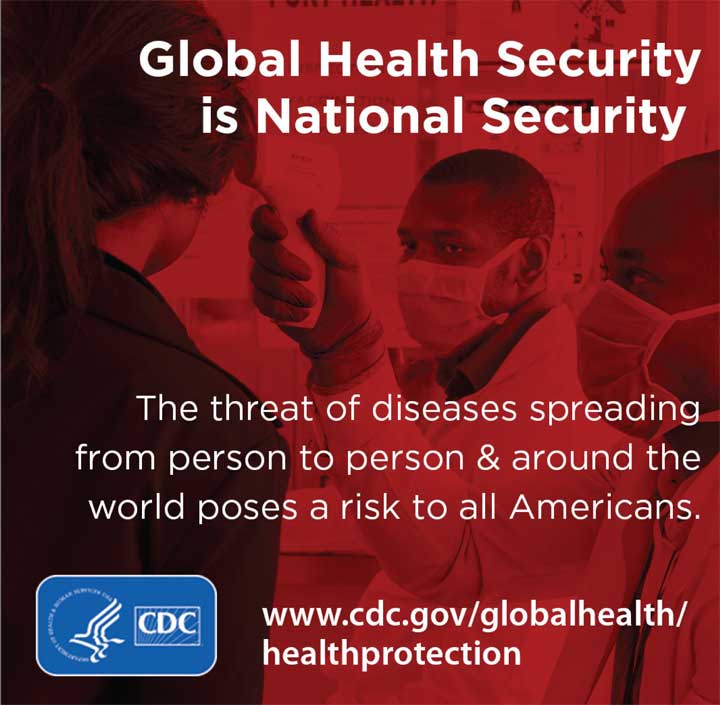CDC Shows the Economic Impact of GHSA
Manufactured Goods: Machinists, assembly line workers, welders, quality control inspectors, mechanical engineers, tool and die makers, machine tool programmers.
Agriculture, Forestry, Fishing & Hunting: Laborers, managers, truck drivers, equipment operators, cattle ranchers, loggers, commercial fishers.
Mining, Quarrying, and Oil/Gas Extraction: Extraction workers, geological engineers, equipment operators, truck drivers, structural designers, drill operators.
Today’s world of increasing interconnectivity and mobility accelerates the shared global risk to our health. An infectious disease can be transported from an isolated village to major cities on all continents in less than 36 hours.
Public health emergencies can have devastating effects on local, regional, and global economies. They disrupt markets, destabilize political structures, threaten business operations, and endanger workers’ health. Nations can be hit hard by the cost of controlling diseases: governments and the private sector often have to deal with the burden of decreased travel and tourism, lost business continuity, surges in health care costs, and disrupted trade with international markets. Economists estimate that the 2002–2003 SARS outbreak cost the global economy $40 billion.2 Likewise, according to a recent estimate by the U.S. National Academies of Science, Engineering, and Medicine (NASEM), pandemics could cost the global economy over $6 trillion (USD) in the 21st century.3
In addition to tragic loss of life, the next global infectious disease outbreak could harm the U.S. export economy and threaten U.S. jobs—even if the disease never reaches American shores.

Disease outbreaks can cause economic disruption. Decreasing demand for U.S. exports. Putting U.S. export-related jobs at risk. Global health security helps safeguard America's health and economic stability. Learn more about health security and its economic impact at the global health protection website.
As of 2015:
- The U.S. had exports valued at over $277 million to the 17 Phase I countries in sectors including agriculture, manufacturing, and natural resource extraction4
- These exports to the 17 Phase I countries supported more than 345,000 U.S. jobs5
The U.S. economy is better protected when public health threats are quickly identified and contained. CDC’s global health security efforts to stop outbreaks where they start protects the health of people worldwide. This, in turn, protects demand for U.S. exports and the jobs they support. Strategic investments in capacity building and preparedness for health security purposes must remain a national priority of governments and a key commitment for multilateral agencies, development banks, non-governmental organizations, and private sector stakeholders worldwide.6, 7
Partnering to Protect America’s Future
There is perhaps no greater investment toward protecting our physical, social, and economic wellbeing than global health security.
No single country, sector, or organization can achieve global health security alone. Non-governmental organizations, academia, state and local governments, faith-based organizations, and the private sector all have a stake in the success of this endeavor. Their investments, workforce, and bottom line are impacted by the capacity of public health systems around the globe to contain outbreaks. Multi-sectoral collaboration and public-private partnerships are critical to ensuring the world is ready to prevent, detect, and respond to the next public health emergency.

Global Health Security is National Security. The threat of diseases spreading from person to person and around the world poses a risk to all Americans. Learn more about health security at the global health protection website.
A strong, multi-sectoral commitment to global health is vital to saving lives, spending dollars wisely, and protecting U.S. business interests. But partnership opportunities need not be limited to financial support; there are many opportunities for engagement. Now is the time for each entity to look at what it can offer the global community. Whether it be technical experts who help guide policy and grow capacity; partner organizations who can offer support, supplies, or resources; or community members who can communicate important health information and help report outbreaks early, opportunities for contribution are endless and necessary.
Every sector can play an active, strategic role in enhancing preparedness and response efforts here in the United States and abroad. There is strength in leveraging our complementary skills and resources. We can achieve more together than we can alone.
Examples of GHSA activities partners have engaged in with CDC:
- Building temporary and permanent emergency operations centers in Sierra Leone, Liberia, and Guinea during the 2014 Ebola outbreak
- Providing direct support to frontline response efforts
- Advocating for open trade and humanitarian corridors
- Training laboratory scientists and technologists across 17 priority countries
- Developing partnerships that were instrumental in promoting both domestic and international preparedness during the Zika response
- Collaborating with public health partners around the world to align communication strategies before and during public health emergencies
- Using technical exchanges and twinning partnerships as a unique response and recovery strategy
- Mobilizing private industry engagement and health system strengthening
- Developing sustainable, national infection prevention and control policies and programs
- Solving global health challenges through new technologies, medical countermeasures, and innovative approaches
- Raising awareness about lifesaving work that protects U.S. national security and economic interests
- Improving global supply chains and developing innovative approaches for delivering and implementing products and services
- Developing evidence-based guidelines and using health data to protect workers from health, occupational, and environmental hazards
- Providing expertise in areas such as construction, logistics, distribution services, vehicles, and delivery of fuel and medical equipment to affected areas; also routing ambulances to pick up individuals for care from remote areas
2 Institute of Medicine (US) Forum on Microbial Threats; Knobler S, Mahmoud A, Lemon S, et al., editors. Learning from SARS: Preparing for the Next
Disease Outbreak: Workshop Summary. Washington (DC): National Academies Press (US); 2004. The Impact of the SARS Epidemic. Available from:
https://www.ncbi.nlm.nih.gov/books/NBK92486/external icon.
3 Gostin, L.O., Mundaca-Shah, C.C., & Kelley, P.W. (2016). Neglected Dimensions of Global Security: The Global Health Risk Framework Commission.
JAMA, 315(14), 1451–1452. https://scholarship.law.georgetown.edu/facpub/1774external icon.
4 US Department of Commerce, International Trade Administration (ITA). Jobs supported by export destination. http://www.trade.gov/mas/ian/build/groups/public/@tg_ian/documents/webcontent/tg_ian_005513.xlsxexcel iconexternal icon
5 US Department of Commerce, International Trade Administration (ITA). Trade Policy Information System (TPIS database http://tpis1.trade.gov/cgi-bin/wtpis/prod/tpis.cgiexternal icon
6 Cassell, C.H., Bambery, Z., Roy, K., Meltzer, M.I., Ahmed, Z., Payne, R.L., & Bunnell, R.E. (2017). Relevance of Global Health Security to the US Export
Economy. Health Security. 15(6);563–586. doi: 10.1089/hs.2017.0051
7 Bambery, Z. Cassell, C.H, Bunnell, R.E., Roy, K., Ahmed, Z., Payne, R.L., Meltzer, M.I.(2018). Impact of a Hypothetical Infectious Disease Outbreak on
US Exports and Export-Based Jobs. Health Security. 16(1):1–7. doi: 10.1089/hs.2017.0052